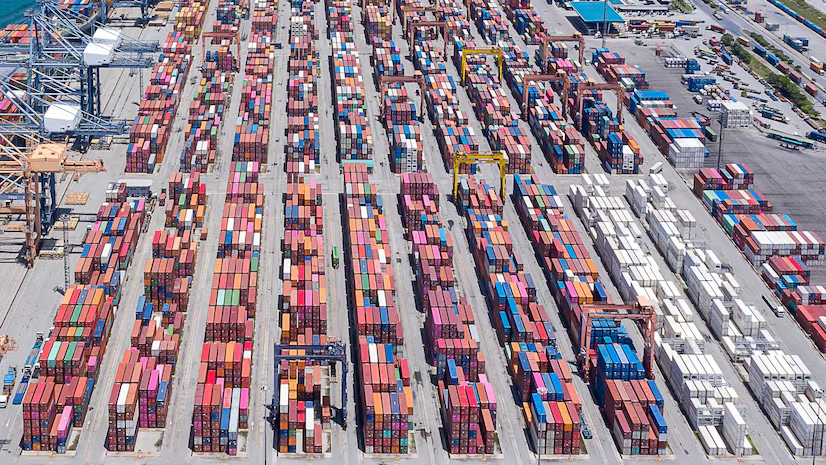
International trade and the Indian Economy: Impact of Declining Rupee
We need to strengthen the value of Indian Rupee and to re-establish the brand Swadeshi around the world.
Dr. Dhanpat Ram Agarwal
There has been a very close nexus between India’s international trade and its
economy since very early days. India was a major player with a favourable balance of trade until the invasion of the colonial powers in the 17th-18th century and had been the richest nation in the World with a share of more than 25 percent of the global economy.
Pre-Colonial period and post-colonial period before independence in 1947
India was a prominent player in international trade before the colonial era. Pre-colonial India had been brimming with potential, establishing itself successfully on the international map. India enjoyed a solid worldwide reputation. India was famed for its handicraft industry in cotton and silk fabrics, metallic and valuable stone production, and other sectors.
During pre-colonial period India’s exports included several precious Kashmiri Shawls, carpets, Varanasi silk sarees, jewellery, brass, copper, bell metal wares, marble work, ivory, wood, stone, and artistic glassware. Spices: Cinnamon, pepper, opium, and indigo. Various raw materials like raw cotton, opium, and indigo. Food crops like ( Rice, wheat, sugar, and other items like precious stones, and drugs. India’s imports included Pearls, wool, dates, dried fruits, and rosewater from the Persian gulf, Coffee, gold, drugs, and honey from Arabia, Tea, sugar, and silk from China, Gold, musk, woollen cloth, metals like copper, iron, and lead, and paper from several other countries including Persia.
The Silk Road was the major trade route connecting India with China along with other routes through Kandahar to Persia. Goods were transported by caravans of oxen and donkeys in the dry seasons, and by coastal and river shipping.
Vasco da Gama, a Portuguese explorer was the first European who arrived at Calicut in 1498 and thereafter many others from Dutch, France and British started coming and slowly colonised major part of the Indian Territory. However during the British Rule the surplus generated through exports of commodities were drained out in the name of taxation and other government expenditures. India was relegated to a provider of raw resources such as jute, wool, indigo, cotton, and sugarcane and an importer of completed consumer products such as silk & woollen clothing and small machinery created in British industries during colonial control. Furthermore, the development of the Suez Canal increased British influence over Indian international commerce.
India’s share in the global economy was reduced from more than 25% in 1757 to just 2.5% in 1947 with a massive wealth piracy by the British Rulers estimated to be nearly US$ 45 trillion in the present value as per the research study of Utsa Patnaik, a famous economic historian.
India’s independence and international trade
India followed a very cautious approach of inward looking and import substitution after independence and gradually improved upon our foreign trade policy which is evident from the fact that our volume of international trade moved upwards in a slow motion for a long time from a meagre US$ 2.5 Billion in 1950 to around US$ 10 Billion in 1975-76 and US$43 Billion until 1990-91. It took almost a double jump to US$ 95 in 2001-02 and thereafter a long jump of US$ 620 Billion in 2010-11. At present the volume of international trade has reached to US$ 758 Billion. However if we look at the gap between the import and the export of the merchandise, We find a huge trade deficit of around US$ 250 Billion which will be clear from the following discussion.
India’s trade account deficit has been rising continuously and reached US$ 241.143 Billion in 2023-24. There are two major components of trade account deficit, one is for crude oil and petroleum products and the other is for different merchandise. The oil deficit was US$ 94.576 billion and non-oil US$ 146.567 billion. In the Financial year 2013-14 the trade account deficit was US$ 135.798 billion of which US$ 101.591 was on oil account and US$ 34.207 on non-oil or on account of merchandise. During these corresponding years Exports have increased from US$ 314.416 billion to US$ 437.072 billion and the imports have increased from US$ 450.214 billion to US$ 678.215 billion. However the increase in oil imports is very marginal i.e., from US$ 164.770 billion to US$ 178.773 billion. In other words the increase in imports of non-oil merchandise during this corresponding period has increased substantially by US$ 228 billion as compared to increase in oil which is only US$ 14 Billion and therefore the major chunk of increase in trade account deficit during the corresponding period of 10 years is due to substantial increase in the merchandise related to non-oil products.
We import majority of the non-oil merchandise from China and our trade deficit on account of imports from China during the current financial year 2023-24 was US$ 85.10 billion, our imports being US$ 101.75 billion and exports being US$ 16.65 billion. This is despite our all-out efforts to reduce our imports from China. We could neither increase our exports nor reduce our imports to the desired levels despite introducing production link incentives and with our Make in India initiatives. On the other hand if We look at China We find that it has positioned itself at number one in the international trade and that is mainly because of its cheaper goods which are in demand in each country and from each continent and from the rich as well as poor countries. Its export in the calendar year 2023 was US$ 3.58 trillion while its import was only US$ 2.59 trillion and thereby a trade surplus of US$ 990 billion as compared to the trade surplus of US$ 838 in the year 2022 as will be evident from the above chart.
Impact of Foreign Capital
It is evident from the tables below that the current account deficit is met out of capital receipts on three major ways, namely foreign direct investment, foreign portfolio investment and external commercial borrowing or the external debt. The cumulative inward flow of FDI from April 2000 to September 2024 is US$ 1033.400 billion or a little more than one trillion US$ as per the latest published data of Government of India and if we exclude the FDI receipts from NRIs under Remittance scheme the net FDI inflows during this period is US$ 708.654 billion. This also includes the reinvestment of the retained earnings to the extent of US$ 239.084 billion. The present market value of the foreign portfolio investments is approximately US$ one trillion. The net external debt as on 30/09/2024 as per the Department of Economic Affairs is US$ 711.808 Billion. Thus the total foreign capital which is invested in the country at present is US$2.7 Trillion. The point to understand is that We have been adding a minimum of about US$ 150-200 billion every year on account of these three namely FDI, FPI and External Debt on account of trade account deficit and current account deficit and if this situation continues for another couple of years we may have to face the similar BOP crisis as our Forex Reserve which is nearly US$ 700 billion is only about one fourth of the total foreign capital. Indirectly we are under a vicious cycle whereby dependence on foreign capital has become a compulsion and not a choice.
Declining Rupee
As a consequence of withdrawal of funds by FII from the Indian Stock Market and slowness of export, the Rupee has declined from Rs 83.8 in September 2024 to Rs 86.58 as on January 17,2025 and is on a continuing downward journey from Rs 63 in December 2014. The basic reason for perennial trade account deficit and as a consequence the continuous decline in the value of Indian rupee is a major area of concern. The cumulative impact is our increasing dependence on foreign capital to meet the trade deficit which is partly met by service exports and partly by foreign remittances from NRIs. The inflows of foreign direct investment although help in meeting our foreign exchange requirements to meet the trade account or the current account deficit but it also entails a liability to service through dividend, royalties and technical fees as FDI generally comes with a burden of foreign technology and also create challenges for domestic industry. The increasing burden of foreign goods, foreign technology and foreign capital in the form of foreign debt, foreign portfolio investments in the stock market and of the FDI has started creating a dent in our economy and on our economic sovereignty and the time has come for a serious introspection and self-analysis.
It has an indirect impact on our MSME sector and on the unemployment. The declining rupee brings with it the impact on imported inflation as our prices for imported oil becomes more costly and our manufacturing with imported components also becomes less competitive although there is a cross argument that our exports become more competitive but empirical evidences so far has shown adverse results. Had it been so in the last more than 30 years the rupee has declined from Rs 16 in 1991 to nearly Rs 87 now but our imports have been rising and at a much faster rate than our exports. Our trade deficit was hardly US$ 5 billion in 1991 which has increased to nearly US$250 billion now.
The challenge before the Indian economy is to restore to Swadeshi ideology with utmost focus on research and innovation and to regain the status of the most industrialised country by improving the quality and price competitiveness of the local products.
Today we talk of self-reliance and ‘Atma Nirbhar Bharat’ but it is ridiculed by the fact that our market is flooded by imported goods. Most of the household goods and white goods including refrigerator, washing machine, air conditioner, automobile and mobile phone are imported. This is the reason of our increasing trade account deficit, the increasing unbearable burden of foreign technology and of foreign capital in the country.
The Central Government is trying to develop indigenous technology but the slogan and the mission of “Vocal For Local” is yet to see the light of the day. To make India a developed economy by 2047 our goal is to restore its glory which it enjoyed during the pre-colonial period. We need to strengthen the value of Indian Rupee and to re-establish the brand Swadeshi around the world.


